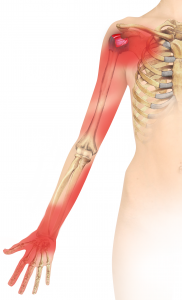http://www.jshoulderelbow.org/article/S1058-2746(04)00274-5/abstract
The purpose of this study was to investigate the ligamentous restraints and muscle effects limiting external rotation of the glenohumeral joint in a biomechanical cadaveric model.
External rotation torque was applied to the humeri of 15 shoulders mounted in the supine position in a custom fixture while varying rotator cuff and biceps loads in 15° and 60° of glenohumeral abduction.
A randomly chosen ligament (coracohumeral ligament [CHL], combined superior and middle glenohumeral ligaments [S+M], anterior band of the inferior glenohumeral ligament [AB], entire inferior glenohumeral ligament [IGHL], or posterior capsule [PC]) was cut, and testing was repeated (n = 3 for each ligament).
In the neutral position, each ligament except the PC significantly affected the torque required for external rotation, with IGHL > CHL > AB > S+M. In this position, loading the subscapularis to 44.5 N significantly increased the torque required to externally rotate the shoulder whereas unloading it significantly decreased the torque required.

In the 60° abducted position, each ligament except the PC significantly affected the torque required for external rotation, with IGHL > AB > S+M > CHL. In this position, loading the biceps or subscapularis to 44.5 N significantly increased the torque required to externally rotate the shoulder as rotation increased whereas unloading it significantly decreased the torque required as rotation increased.
This work demonstrates that the glenohumeral joint capsule behaves as a cylinder with many regions serving as restraints to external rotation.
In addition, the long head of the biceps has an important role as a dynamic restraint to external rotation in the abducted shoulder. This is a new function attributed to the biceps and reinforces the role of external rotation in the generation of biceps and superior labral pathology.